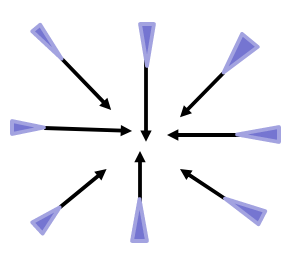CA Current Framework#
Current implementation of Collision Avoidiance for the multi-agent UAVs is using tyhe velocity obstacles implementation. This relies on the relative velocity vector and Protected Zone to prevent collision.
Refer to paper :
Y. Kuwata, M. T. Wolf, D. Zarzhitsky and T. L. Huntsberger, "Safe maritime navigation with COLREGS using velocity obstacles," 2011 IEEE/RSJ International Conference on Intelligent Robots and Systems, 2011, pp. 4728-4734, doi: 10.1109/IROS.2011.6094677.
https://ieeexplore.ieee.org/document/6094677
Problems Identified from Current CA#
Collisions occur, especially when congested
Unnecessary avoidance, disrupting mission
Not following rules properly all the time
Unfairness, some drones do all the work to avoid
Deadlock in tight spaces
Shallow crossing encounter, the two drones struggle to pass each other and could go into deadlock
Simplify the parameters (update rate, latency, detection range, etc) – too many and they are actually related and not easy to determine what value to assign
Priority issue – when a drone is given highest priority, are we sure others would be able to avoid it while it ignores everyone else
Handling static obstacles
Conjectures of New CA#
Adjustment of trajectory in a mutually agreed opposite direction (pass on the right side rule) will converge stably in a non-oscillatory manner when the maneuver is half or less than what is required to avoid => deadlock won’t occur because the state of deadlock is an unstable equilibrium
A resolution is always possible because the drones are assumed to start on a collision-free path and they would not change their trajectories unless it is collision-free (eventually – because they only change by half or less than what is required)
The model to approximate the trajectory of the drone is representative of the actual trajectory => violation of PZ will only be because of failing to use a good model of the drone and associated buffer for uncertainties
Gradient descent – there is a no local minimum in the cost function
Collision Test Cases#
Basic :#
| Passing Static UAV | Crossing | Head On | Overtaking | Shallow Crossing |
|---|---|---|---|---|
Advance :#
| Antipodal | Lawn Mowing | Orbit | Narrow Spaces |
|---|---|---|---|
 |
Considerations for implementation#
When no solution is found, we stop the drone. Note that stopping would not work if other drone is higher priority and does not try to avoid it
This algo may require a low level, more reactive algo as a last line of defence to avoid others. To think about this later and to define its role and for what cases it is needed. It could be:
- The current CA algo itself
- A simple repulsion rule
Optimization of implementation#
- Collision Check : May not need to propagate with small time steps and there may be a smarter way to do this more efficiently.
- Fairness in avoidance : We can exchange costs and moderate manAmt as a function of my cost vs your cost.